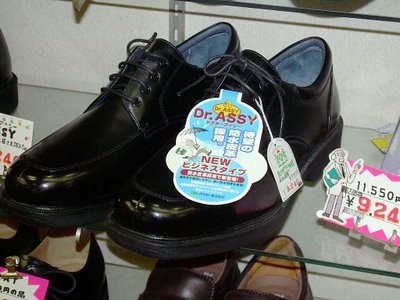The information I found states that there is a fixed fee schedule for any given procedure and that no doctor (or dentist) regardless of experience, expertise or antiquity or modernity of equipment may charge more or less than the fee schedule states. One of the consequences of this is that doctors offer very short consultation times and require multiple visits. The average doctor sees 49 patients a day. Thirteen percent see a hundred patients a day.
Essentially, the doctors have found a way to make more money despite the limits placed on what they may charge. Unfortunately, it's this sort of thing that supports all the arguments against socialized health insurance in the states. The Japanese situation bears out the notion that the quality of care will diminish with nationalized insurance.
My experience also bears this out and it may be one of the reasons why I've come to believe doctors never listen to their patients. My experience in Japan, except when dealing with the doctors who specialize in care for foreigners and don't take national health insurance, is that doctors spend very little time with you and shuttle you out as quickly as possible. In the case of my dental "check-up", the dentist looked at my teeth for no longer than 2 minutes, possibly less, then turned me over the the hygienist for cleaning. I believe that they had me come back for split billing. They could charge once for consultation and a second time for cleaning.
The fee schedule situation also explains the tendency among Japanese doctors to prescribe at least 3 kinds of medicine to patients during each visit. When the cost of the medicine is lower than the scheduled expense, the clinic or hospital the doctor is a part of gets to make more from the medication. Both this sort of over-prescription and short consultation times are specifically discussed in a paper I read here. It's quite interesting and I recommend anyone who wants to understand more about the structure of the health system give it a read.
After having my lower teeth scraped at and polished up, my husband, my sore gums and I went shopping for shoes. My husband has been in rather dire need of a new pair for quite some time. This was a point that was dramatically brought home by yesterday and this morning's rain.
 There's a relatively cheap shoe shop in a rundown arcade near Asagaya station that we stopped in on. I was amused to see the shoes with the peculiar name pictured above. I'm guessing that "assy" is a play on a Japanese word related to being water-tight since the selling point on these shoes according to the tag is that they have special heels to prevent water from leaking into them when it rains. My husband didn't buy these particular shoes though. I'm not sure that one could buy a brand named "Dr. Assy" and wear them without feeling self-conscious. Additionally, they were more expensive than he was looking to pay. In the end, he picked up a pair of business shoes for about 4,000 yen (about $36) and new tennis shoes for about 2,000 yen (about $17).
There's a relatively cheap shoe shop in a rundown arcade near Asagaya station that we stopped in on. I was amused to see the shoes with the peculiar name pictured above. I'm guessing that "assy" is a play on a Japanese word related to being water-tight since the selling point on these shoes according to the tag is that they have special heels to prevent water from leaking into them when it rains. My husband didn't buy these particular shoes though. I'm not sure that one could buy a brand named "Dr. Assy" and wear them without feeling self-conscious. Additionally, they were more expensive than he was looking to pay. In the end, he picked up a pair of business shoes for about 4,000 yen (about $36) and new tennis shoes for about 2,000 yen (about $17).Finally, I'd been craving a Mont Blanc for ages and hadn't been anywhere that sold decent ones so my husband suggested we visit the Cozy Corner near the station. Cozy Corner carries a variety of elaborate sweets that are heavy on the whipped cream and somewhat expensive. I think we buy something from one of these places once every 3-5 years.

I picked out two Mont Blanc from their relatively large collection of varieties. The one on the left is a "forest Mont Blanc". It includes more fresh cream filling and less cake than most of the Mont Blanc you can get in Japan as you can see from the picture below.

Mont Blanc is an Italian dessert (or French depending on what you read) which is meant to resemble a white mountain. The top is made of piped chestnut paste and the base is often meringue but all of the ones I've seen in Japan have cake as the base. The paste is made in a variety of ways but generally involves boiling chestnuts in milk, sugar and vanilla then adding in a little brandy.
These must be pretty popular in Japan because variations of them are sold in most supermarkets and convenience stores. They range from being extremely sweet to fairly bland. I prefer the less sweet variety but I'm afraid the Cozy Corner ones are really sweet. I'll have to keep that in mind in another 3 years or so when it occurs me to patronize one of them again.
No comments:
Post a Comment